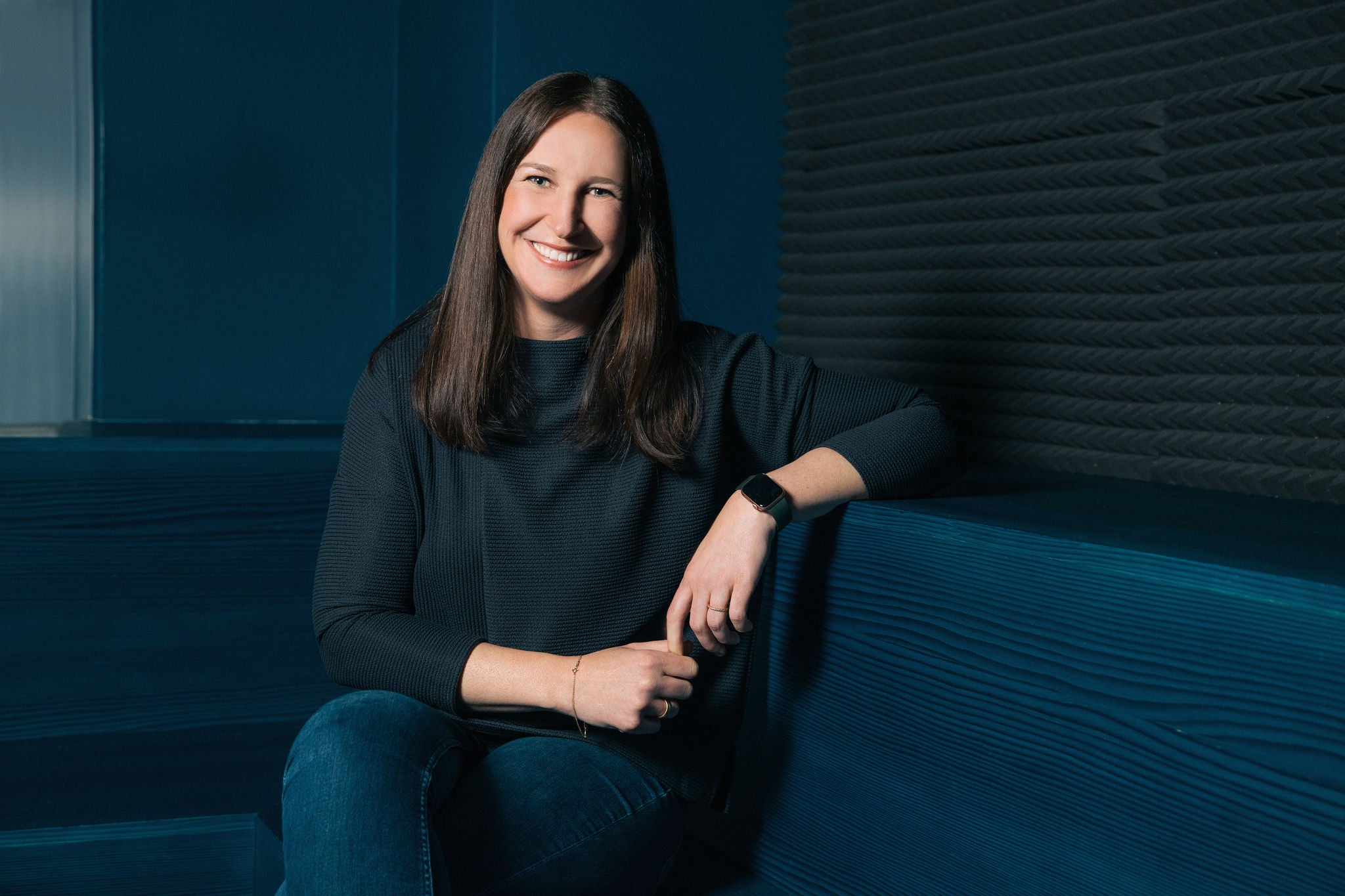While humans remain crucial in a partially automated advertising industry, they can only cope with the complexity of the various channels and their idiosyncrasies with real-time computer support. That’s why it’s not a question of WHETHER we use AI in media and marketing, but HOW and where we use it. And how we organise, orchestrate and regulate interaction between humans and machines.
When we talk about AI at Mediaplus, we tend to interpret the term as “Augmented Intelligence”. It combines the human brain, with all its knowledge and experience gained over decades, with the new possibilities offered by machine learning and artificial intelligence. Depending on the process and task, there are a wealth of different models when it comes to how humans and machines collaborate and share responsibilities.
According to a study by the German Association for the Digital Economy (BVDW), 40 per cent of German companies state that applications with generative AI are used several times a week at their respective companies; only 7 per cent never use them. AI is ushering in a new era or phase of brand management. However, it will only expand the market share of companies and brands that use it faster, more consistently, more intelligently and more precisely for their own needs. In order to decide which set of data and tools makes sense at which stage of media planning, we need highly trained experts to select the data and tools or program their own applications for the specific use case.
The aim is to make our solutions and media delivery more intelligent for our clients. No less important is the objective of making the ever-increasing complexity tradable for the agency and keeping it transparent for the client. At the same time, our media talents should focus more on strategic issues than on pure execution. The right mix of human and artificial intelligence and finding the right employees with the right skills – or training them appropriately – will be key to staying ahead of the field.
But AI is not only as good as the human who controls it, but also only as good as the data with which it is trained. But what is the ‘right’ data? This depends on the initial situation and the advertiser’s brief. This could be usage data from the mobile and fixed-line Internet, from social networks, from benchmark campaigns, but also large volumes of first-party data from clients (point of sale, target group data, price information, data on competitors, etc.) or data from market research (consumer panel, consumer research). The particular challenge in our day-to-day work is to identify, devise and put into operation the appropriate set of data and tools for the respective client in such a way that we can optimise them as the process unfolds – ideally in real time. For this to work, high-quality data is essential.
In order to achieve optimum advertising impact, we – as an international group of media agencies – have defined a planning process for our work that guides us in the use of AI across national borders. This process structures requirements and enables us to assign the correct procedures, (AI) tools and data to each step of the process. This not only facilitates mutual learning within our group, but also sets standards and points of reference.
To illustrate where we at Mediaplus already use AI – either fully or partially – in the process of media planning and communication coordination, here are five specific examples from different phases of this process:
1. Media mix/media strategy: Growth Investor
Which media mix and/or which media strategy suits the respective task that advertisers set us? To answer this question with empirical values and figures from thousands of campaigns – supplemented by performance and impact data, prices and much more – we developed ‘Growth Investor’.
It masters the burgeoning complexity of the media landscape and is our answer to ever-increasing media fragmentation. Growth Investor combines all media factors relevant to decision-making in one high-performance tool and uses AI to maximise the ROI of media investments – and does so in a holistic, impact-based way across all activities. Configured individually for each brand with objectives, target groups, budgets and conditions, the Growth Investor AI identifies the most effective and efficient media mix out of millions of potential combinations.
Based on the objectives of advertisers, Growth Investor recommends which channels and media types should be used and how the budget should be distributed across the media mix in percentage terms. Selecting the top-performing placements and formats within media and channels is then a manual task for the media planners. Depending on specifications, the machine then monitors campaign results and performs optimisation work in real time.
In other words, AI makes a strategic recommendation, while humans review it, handle detailed planning and assume responsibility for the results. Example two demonstrates how collaboration between humans and machines works in programmatic advertising.
2. AI-based targeting without third-party cookies (NE.R.O AI)
Due to the imminent disappearance of third-party cookies, we as an agency have considered alternatives in order to restructure the delivery of digital campaigns. The solution: contextual AI-based targeting. To this end, we have further developed our proven targeting tool NE.R.O (which stands for ‘net range optimisation’) for use with artificial intelligence.
The NE.R.O AI crawler scans more than 50,000 items on the Web every single day, processing millions of data sets that continuously train the AI with new content. NE.R.O AI uses a large language model to understand the context, affinities, and psychographic/emotional structures and themes of the articles. Using this information, it assigns appropriate target groups – based on value planning – to the relevant articles, which are then used for campaign management. Ads for a travel destination appearing next to an article about the plague of jellyfish in the same place is now a thing of the past. By the same token, luxury hotels are no longer suggested to campers. AI helps to create an optimal fit for the target group. And although the campaigns do not use cookies, we can still manage them highly individually. Initial results from real campaigns show that NE.R.O AI performs significantly better than traditional profile targeting – achieving, for example, a 90 per cent higher dwell time and a 21 per cent higher click-through rate.
But what if the advertiser is unsure about whether the intended target group is the right one for their advertising? Here, too, the machine-based super brain can help.
3. Target group modelling: Persona GPT
In the world of marketing and communications, audience data and analysis is a broad field. Experts from different disciplines generally consider their target groups from different perspectives. With this in mind, we’re developing Persona GPT, an AI-assisted audiovisual interface that allows planning teams to interactively request more information about the respective target group, just like with a chatbot.
In contrast to conventional chatbots, however, we feed Persona GPT with a wide range of high-quality data sources (including AGF, Best for Planning, GWI, Nielsen and YouGov, as well as specialised industry data). An electricity provider, for example, wants to attract people who are looking to switch and, to this end, would like to receive basic information about the living environment of their target group. The creatives ask about their attitudes and values. The strategic planners want to find out what is most important to the target group when switching electricity providers. The media planners want to know which media are primarily used by the target group. Persona GPT always answers directly and enables questions to be asked at any point in the dialogue, thus making creation and planning interactive, intuitive and significantly faster.
4. Sustainable advertising: Green Ad
Artificial intelligence can also help us on the even longer journey towards a more sustainable advertising industry. With Green Ad, for example, we have developed an AI-based tool that compresses existing digital advertising materials – without any loss of graphic quality – and thus reduces the amount of data. This can reduce the advertising material’s carbon footprint by up to 75 per cent in some cases. Taking an average digital campaign with 24 million ad impressions, around 230 kg of CO2 can be saved. This is the equivalent of a flight from Berlin to London, no less.
5. Creation: AI as a turbocharger for efficiency and advertising impact
When it comes to creative implementation, such as photo shoots and video productions, artificial intelligence is, first and foremost, an efficiency booster. But not in the sense that it allows you to produce very cheap but completely interchangeable stock photos. With creative AI support, completely new images can be created on the one hand and, on the other, customised versions of existing brand images can be produced at unprecedented speed and quantity.
But do these creative advertising materials actually work? With the ‘Emotion Engine’, we at Mediaplus have a database of more than 3,000 classically tested advertising materials. The qualitative and quantitative emotional review checks the creative output in each individual sequence. When do sympathy, attraction, relevance and reflection increase? Where do the curves flatten out and why? And what emotions does the campaign generate amongst different target groups? New measurement data and evaluations are continuously fed into the Emotion Engine. Once the results produced by these advertising materials are known, the impact of new advertising materials can be analysed using AI BEFORE the campaign and optimised even before it goes live.

These are just a few examples of how media agencies can use AI. We are continuously testing new application scenarios for the use of machine learning and artificial intelligence in the media – but only where it makes sense.
Our job is to provide advertising clients with more guidance in times of growing complexity. This is the basis for better media investment decisions. Advertising clients will need even more support and advice in the future, but a media agency will only be able to provide high-quality advice if it is able to draw on a continuously optimised database and corresponding predictive models. AI is the key and the foundation in this regard. AI enables us to provide high-quality advisory services in all areas with the aim of achieving increasingly differentiated and target group-specific communication across all possible channels – despite requirements increasing exponentially due to the growing fragmentation of channels.
But the decisive competitive factor lies in the people who are able to evaluate the possibilities and limitations of new technology, our augmented intelligence. Our focus is on expanding this form of AI.
Author: Matthias Brüll, CEO Mediaplus Group
Interested in more content?
Back to Issue #16









